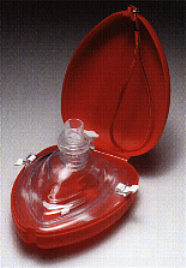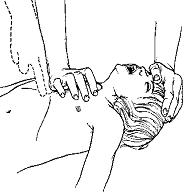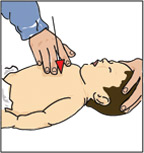





CPR
 |
 |
 |
 |
 |
 |
Introduction
If you have ever watched a TV show with a medical setting, you've probably seen someone perform cardiopulmonary resuscitation. That's when a doctor or another rescuer puts air into someone's mouth and presses on the person's chest. It's called CPR for short and it saves lives.
What Is CPR?
Cardio means "of the heart " and pulmonary means "of the lungs." Resuscitation is a medical word that means "to revive" — or bring back to life. Sometimes CPR can help a person who has stopped breathing, and whose heart may have stopped beating, to stay alive.
People who handle emergencies — such as police officers, firefighters, paramedics, doctors, and nurses — are all trained to do CPR. Many other teens and adults — like lifeguards, teachers, child-care workers, and maybe even parents — know how to do CPR as well.
Here's what takes place during CPR: A person giving CPR — called a rescuer — will give some breaths to someone who is not breathing on his or her own. This is called artificial respiration, mouth-to-mouth rescue breathing, or mouth-to-mouth resuscitation.
To do this, a rescuer puts his or her mouth over the other person's open mouth and blows, forcing air into the lungs. (Ideally the rescuer will use a special mask so that their mouths do not actually have to touch.) Rescue breathing helps to move oxygen down into the lungs of the person who is not breathing.
After giving two breaths, the rescuer will probably use both hands, one placed over the other, to press on the person's chest many times in a row to move blood out of a heart that has stopped beating. These are called chest compressions and they help move oxygen-carrying blood to the body's vital organs — especially to the brain. A person who goes too long without oxygen reaching the brain will die. After 30 chest compressions have been given, two more rescue breaths are given and the cycle continues until help arrives.
In between chest compressions, the person's rib cage relaxes long enough to let blood flow back toward the heart. In this way, the rescuer can keep the person alive by continuing to supply blood and oxygen to the brain and the rest of the body, until emergency help — like the paramedics — arrives to take the person to a hospital.
Instead of doing mouth-to-mouth rescue breathing, professional rescuers — such as paramedics — will provide artificial breathing for someone by using a mask with a special hand pump connected to an oxygen tank. Doctors in the emergency department will put a tube into the person's windpipe to pump oxygen directly through the tube and into the lungs.
When Should Someone Use CPR?
The steps in CPR should be used whenever someone is not breathing and when the heart is not beating. After a couple of rescue breaths are given, 30 chest compressions should be started right away.
Someone can stop breathing and/or have cardiac arrest from:
If an emergency happens or someone becomes very sick while you're around, do your best to stay calm. First, try to get the person to respond by gently shaking his or her shoulder and asking, "Are you OK?" If there is no response and you are certified in CPR, you can begin CPR. If you're alone, shout for help or call 911 yourself.
Who Should Know CPR?
Certain people need to know how to perform CPR to do their jobs. Medical professionals — from nurses and doctors to paramedics and emergency medicine technicians — must know CPR. Lifeguards, child-care workers, school coaches, and trainers usually have to learn CPR. Many parents know how to perform CPR on their children in case of emergency. Other adults who have family members with medical conditions such as heart disease sometimes know CPR, too.
Many people — maybe you — may want to learn how to do CPR just in case they need to use it someday. You can never tell when a medical emergency will happen and it feels good to know that you could help. The American Red Cross, American Heart Association, and the National Safety Council all offer CPR courses. You also might find CPR classes at your local hospital, places of worship, the YMCA, or your school. You are usually ready to take a CPR course and get certified if you are in middle school or above.
Talk with your mom or dad if you'd like to learn how to do it. Knowing CPR can be a real lifesaver!
Disclaimer: This information is not intended be a substitute for professional medical advice. It is provided for educational purposes only. You assume full responsibility for how you choose to use this information.
Reviewed by: Kate M. Cronan, MD
Date reviewed: August 2006
PARENTS
Every parent should know how and when to administer CPR. When performed correctly, CPR can save a child's life by restoring breathing and circulation until advanced life support can be given by health care providers.
What Is CPR?
The letters in CPR stand for cardiopulmonary resuscitation, a combination of rescue breathing (mouth-to-mouth resuscitation) and chest compressions. If a child isn't breathing or circulating blood adequately, CPR can restore circulation of oxygen-rich blood to the brain. Without oxygen, permanent brain damage or death can occur in less than 8 minutes.
CPR may be necessary for children during many different emergencies, including accidents, near-drowning, suffocation, poisoning, smoke inhalation, electrocution injuries, and suspectedsudden infant death syndrome (SIDS).
Reading about CPR and learning when it's needed will give you a basic understanding of the concept and procedure, but it's strongly recommended that you learn the details of how to perform CPR by taking a course. If CPR is needed, using the correct technique will give your child the best chance of recovery.
When Is CPR Needed?
CPR is most successful when administered as quickly as possible, but you must first determine if it's necessary. It should only be performed when a person isn't breathing or circulating blood adequately.
First, determine that it's safe to approach the person in trouble. For instance, if someone was injured in an accident on a busy highway, you'd have to be extremely careful about ongoing traffic as you try to help. Or if someone touched an exposed wire and was electrocuted, you'd have to avoid contact with the wire to prevent becoming electrocuted yourself (for instance, using a wooden stick, like a broom handle, to move the wire away).
Once you know that you can safely approach someone who needs help, quickly evaluate whether the person is responsive. Look for things like eye opening, sounds from the mouth, or other signs of life like movement of the arms and legs. In infants and younger children, rubbing the chest (over the breastbone) can help determine if there is any level of responsiveness. In older children and adults, this can also be done by gently shaking the shoulders and asking if they're all right.
The next step is to check if the victim is breathing. You can determine this by watching the person's chest for the rise and fall of breaths and listening for the sound of air going in and out of the lungs. In a CPR or basic life support (BLS) course, participants practice techniques for determining if breathing or circulation is adequate. If you can't determine whether someone is breathing, you should begin CPR and continue until help arrives.
Whenever CPR is needed, remember to call fo emergency medical services. Current CPR courses teach you that if you are alone with an unresponsive infant or child, give chest compressions for 5 cycles (about 2 minutes) before calling for help.
Three Parts of CPR
The three basic parts of CPR are easily remembered as "ABC": A for airway, B for breathing, and C for circulation.
Taking a CPR Course
Qualified instructors use videos, printed materials, and demonstrations on mannequins representing infants, children, and adults to teach proper techniques for performing CPR. The American Heart Association's basic life support course that includes CPR lasts about 3 hours and takes place within one session. The course covers adult, child, and infant CPR and choking.
Participants practice the techniques on mannequins and have opportunities to ask questions and get individualized instruction. The final test for the course is a combination of demonstrating CPR skills and taking a written test.
Because CPR is a skill that must be practiced, it's wise to repeat a course at least every 2 years to maintain your skills. Repeating the course also allows you to learn about any new advances or discoveries in CPR techniques.
Your local chapters of the American Heart Association, the American Red Cross, and local hospitals are good sources for finding a CPR course in your area. Taking a CPR course could help you save your child's — or someone else's — life someday.
Disclaimer: This information is not intended be a substitute for professional medical advice. It is provided for educational purposes only. You assume full responsibility for how you choose to use this information.
Reviewed by: Kate M. Cronan, MD
Date reviewed: August 2006
Originally reviewed by: Steven Dowshen, MD